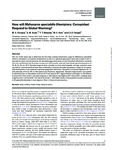Use este identificador para citar ou linkar para este item:
http://www.alice.cnptia.embrapa.br/alice/handle/doc/1058285| Título: | How will Mahanarva spectabilis (Hemiptera: Cercopidae) respond to global warming? |
| Autoria: | FONSECA, M. G.  AUAD, A. M.   RESENDE, T. T. de   HOTT, M. C.   BORGES, C. A. V.   |
| Afiliação: | M. G. Fonseca; ALEXANDER MACHADO AUAD, CNPGL; TIAGO TEIXEIRA DE RESENDE, CNPGL; MARCOS CICARINI HOTT, CNPGL; CRISTIANO AMANCIO VIEIRA BORGES, CNPGL. |
| Ano de publicação: | 2016 |
| Referência: | Journal of Insect Science, v. 16, n. 1, 2016. |
| Páginas: | 6 p. |
| Conteúdo: | The aim of this study was to determine the favorable constant temperature range for Mahanarva spectabilis (Distant) (Hemiptera: Cercopidae) development as well as to generate geographic distribution maps of this insect pest for future climate scenarios. M. spectabilis eggs were reared on two host plants (Brachiaria ruziziensis (Germain and Edvard) and Pennisetum purpureum (Schumach)), with individual plants kept at temperatures of 16, 20, 24, 28, and 32C. Nymphal stage duration, nymphal survival, adult longevity, and egg production were recorded for each temperature*host plant combination. Using the favorable temperature ranges for M. spectabilis development, it was possible to generate geographic distribution. Nymphal survival was highest at 24.4C, with estimates of 44 and 8% on Pennisetum and Brachiaria, respectively. Nymphal stage duration was greater on Brachiaria than on Pennisetum at 20 and 24C but equal at 28C. Egg production was higher on Pennisetum at 24 and 28C than at 20C, and adult longevity on Pennisetum was higher at 28C than at 20C, whereas adult longevity at 24C did not differ from that at 20 and 28C. With these results, it was possible to predict a reduction in M. spectabilis densities in most regions of Brazil in future climate scenarios. |
| NAL Thesaurus: | climate change forage |
| Palavras-chave: | Spittlebug Biological aspects Spittlebugs |
| Tipo do material: | Artigo de periódico |
| Acesso: | openAccess |
| Aparece nas coleções: | Artigo em periódico indexado (CNPGL)  |
Arquivos associados a este item:
| Arquivo | Descrição | Tamanho | Formato | |
|---|---|---|---|---|
| Cnpgl2016JInsectSciHow.pdf | 573,95 kB | Adobe PDF |  Visualizar/Abrir |









